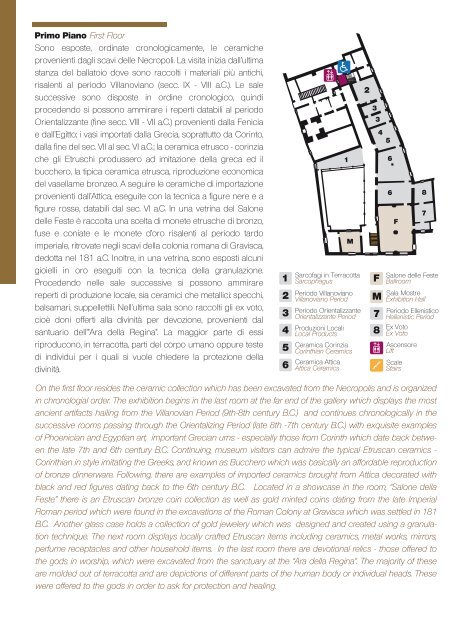Necropoli Etrusca - Tarquinia Resorts
Necropoli Etrusca - Tarquinia Resorts
Necropoli Etrusca - Tarquinia Resorts
You also want an ePaper? Increase the reach of your titles
YUMPU automatically turns print PDFs into web optimized ePapers that Google loves.
Primo Piano First Floor<br />
Sono esposte, ordinate cronologicamente, le ceramiche<br />
provenienti dagli scavi delle <strong>Necropoli</strong>. La visita inizia dall’ultima<br />
stanza del ballatoio dove sono raccolti i materiali più antichi,<br />
risalenti al periodo Villanoviano (secc. IX - VIII a.C.). Le sale<br />
successive sono disposte in ordine cronologico, quindi<br />
procedendo si possono ammirare i reperti databili al periodo<br />
Orientalizzante (fine secc. VIII - VII a.C.) provenienti dalla Fenicia<br />
e dall’Egitto; i vasi importati dalla Grecia, soprattutto da Corinto,<br />
dalla fine del sec. VII al sec. VI a.C.; la ceramica etrusco - corinzia<br />
che gli Etruschi produssero ad imitazione della greca ed il<br />
bucchero, la tipica ceramica etrusca, riproduzione economica<br />
del vasellame bronzeo. A seguire le ceramiche di importazione<br />
provenienti dall’Attica, eseguite con la tecnica a figure nere e a<br />
figure rosse, databili dal sec. VI a.C. In una vetrina del Salone<br />
delle Feste è raccolta una scelta di monete etrusche di bronzo,<br />
fuse e coniate e le monete d’oro risalenti al periodo tardo<br />
imperiale, ritrovate negli scavi della colonia romana di Gravisca,<br />
dedotta nel 181 a.C. Inoltre, in una vetrina, sono esposti alcuni<br />
gioielli in oro eseguiti con la tecnica della granulazione.<br />
Procedendo nelle sale successive si possono ammirare<br />
reperti di produzione locale, sia ceramici che metallici: specchi,<br />
balsamari, suppellettili. Nell’ultima sala sono raccolti gli ex voto,<br />
cioè doni offerti alla divinità per devozione, provenienti dal<br />
santuario dell’”Ara della Regina”. La maggior parte di essi<br />
riproducono, in terracotta, parti del corpo umano oppure teste<br />
di individui per i quali si vuole chiedere la protezione della<br />
divinità.<br />
Sarcofagi in Terracotta<br />
Sarcophagus F Salone delle Feste<br />
Ballroom<br />
Periodo Villanoviano<br />
Villanoviano Period<br />
Sala Mostre<br />
M Exhibition Hall<br />
Periodo Orientalizzante<br />
Orientalizzante Period 7<br />
Periodo Ellenistico<br />
Hellenistic Period<br />
Produzioni Locali<br />
Local Products 8<br />
Ex Voto<br />
Ex Voto<br />
Ceramica Corinzia<br />
Corinthian Ceramics<br />
Ascensore<br />
Lift<br />
Ceramica Attica<br />
Attica Ceramics<br />
Scale<br />
Stairs<br />
On the first floor resides the ceramic collection which has been excavated from the <strong>Necropoli</strong>s and is organized<br />
in chronologial order. The exhibition begins in the last room at the far end of the gallery which displays the most<br />
ancient artifacts hailing from the Villanovian Period (9th-8th century B.C.) and continues chronologically in the<br />
successive rooms passing through the Orientalizing Period (late 8th -7th century B.C.) with exquisite examples<br />
of Phoenician and Egyptian art, important Grecian urns - especially those from Corinth which date back between<br />
the late 7th and 6th century B.C. Continuing, museum visitors can admire the typical <strong>Etrusca</strong>n ceramics -<br />
Corinthian in style imitating the Greeks, and known as Bucchero which was basically an affordable reproduction<br />
of bronze dinnerware. Following, there are examples of imported ceramics brought from Attica decorated with<br />
black and red figures dating back to the 6th century B.C. Located in a showcase in the room, “Salone della<br />
Feste” there is an <strong>Etrusca</strong>n bronze coin collection as well as gold minted coins dating from the late Imperial<br />
Roman period which were found in the excavations of the Roman Colony at Gravisca which was settled in 181<br />
B.C. Another glass case holds a collection of gold jewelery which was designed and created using a granulation<br />
technique. The next room displays locally crafted <strong>Etrusca</strong>n items including ceramics, metal works, mirrors,<br />
perfume receptacles and other household items. In the last room there are devotional relics - those offered to<br />
the gods in worship, which were excavated from the sanctuary at the “Ara della Regina”. The majority of these<br />
are molded out of terracotta and are depictions of different parts of the human body or individual heads. These<br />
were offered to the gods in order to ask for protection and healing.<br />
1<br />
2<br />
3<br />
4<br />
5<br />
6<br />
1<br />
M<br />
2<br />
3<br />
3<br />
4<br />
5<br />
6<br />
6<br />
F<br />
8<br />
7


